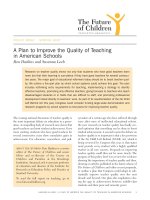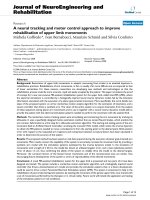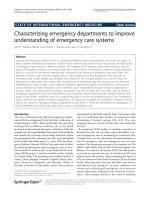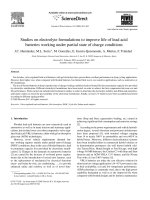Marketing plan to improve brand of samsung washing machine (2011 2012)
Bạn đang xem bản rút gọn của tài liệu. Xem và tải ngay bản đầy đủ của tài liệu tại đây (1.91 MB, 47 trang )
TRƯỜNG ĐẠI HỌC MỞ TP.HCM
UNIVERSITY LIBRE DE BRUXELLES
HO CHI MINH CITY OPEN UNIVERSITY
SOLVAY BRUSSELS SCHOOL
MBMM4
Dang Thi Hoai An
Marketing plan to improve brand equity of
Samsung Washing Machine (2011-2012)
MASTER PROJECT
MASTER IN BUSINESS & MARKETING MANAGEMENT
Tutor’s name: Dr. Nguyen Thang
Ho Chi Minh City
(2011)
i
DECLARATION
I declare that this thesis does not incorporate without acknowledgment any material
previously submitted for a degree or diploma in any university; and that to the best of
knowledge it does not contain any materials previously published or written by another
person except where due reference is made in the text.
Ho Chi Minh City, March 1st, 2011
…………………………………………….
Signature of Student
Dang Thi Hoai An
Master of Business and Marketing Management
ii
ACKNOWNLEDGEMENT
I would express my deep gratitude to my advisor, Dr. Nguyen Thang for his useful
guidance and encouragement.
Thanks are also due to the Solvay Business School and Open University for providing the
Master of Business and Marketing Program, where I learned practical and applicable
knowledge
I also would like to extend genuine thanks to Mr. Serge Bywalski and Ms. Nguyen Thi
Mong Thuy for their support during the implementation of my study.
iii
TUTOR’S COMMENTS
This thesis is a practical one. The objectives were clearly and rationally defined. The
structure is also logical.
The author tried to apply marketing fundamentals together with practical concept and
models to approach and propose the plan. However, the thesis has some limitations such as
survey area, sampling method, or the generalized target population…
In summary, the thesis meets the requirement (both content and presentation) of marketing
master thesis
I propose this thesis to be presented in front of examiner board of the Solvay-OU Master of
Business and marketing Management Program
Ho Chi Minh City, March 1st, 2011
Dr. Nguyen Thang
CONTENT
iv
DECLARATION .................................................................................................................... i
ACKNOWNLEDGEMENT .................................................................................................. ii
TUTOR’S COMMENTS ...................................................................................................... iii
CONTENT ............................................................................................................................ iv
LIST OF FIGURES & TABLES .......................................................................................... vi
1. CHAPTER 1: EXECUTIVE SUMMARY AND PROJECT OBJECTIVE ...................... 1
1.1. Executive summary.................................................................................................... 1
1.2. Project objective ........................................................................................................ 3
1.3. Scope and limitation .................................................................................................. 3
1.4. Project outline ............................................................................................................ 4
2. CHAPTER 2: LITERATURE REVIEW .......................................................................... 5
2.1. .Brand equity and its importance ................................................................................ 5
2.2. .Positioning strategy ................................................................................................... 6
2.3. .Research method & methodology.............................................................................. 7
3. CHAPTER 3: SITUATION ANALYSIS - THE CASE OF SAMSUNG
WASHING MACHINE .................................................................................................... 9
3.1. .Market analysis .......................................................................................................... 9
3.2. .Samsung washing machine business ....................................................................... 10
3.3. .Samsung vs Competitors ......................................................................................... 12
3.4. .Key findings from consumer research survey ........................................................ 15
3.5. SWOT and BCG analyis .......................................................................................... 18
3.6. BCG analysis ........................................................................................................... 21
3.7. Summary .................................................................................................................. 21
4. CHAPTER 4: PROPOSAL OF MARKETING STRATEGY AND
PROGRAMS TO BUILD BRAND EQUITY ................................................................ 22
4.1. Business and marketing objectives .......................................................................... 22
4.2. Segementing, Targeting and Positioning ................................................................. 22
4.3. The marketing programs to build brand equity ....................................................... 26
4.4. Communication strategy .......................................................................................... 31
5. CHAPTER 5: CONCLUSION & RECOMMENDATION ............................................ 35
REFERENCES .................................................................................................................... 37
APPENDICES ..................................................................................................................... 38
v
vi
LIST OF FIGURES & TABLES
List of Figures
Figure 3.1:
Market size and growth of washing machine market ......................................9
Figure 3.2:
Price class share by type ................................................................................10
Figure 3.3:
Market share by brand YTD November 2010 ...............................................12
Figure 3.4:
Brand equity evaluation – key factors influencing purchase decision ...........13
Figure 3.5:
Brand equity evaluation- functional and emotional map ...............................14
Figure 3.6:
Brand equity evaluation- mind share .............................................................14
Figure 3.7:
Key buying factors influencing purchase decision of drum vs. top load .......16
Figure 3.8:
Brand image ...................................................................................................17
Figure 3.9:
Price sensitiveness – drum vs. top load..........................................................17
Figure 3.10: Media habit ....................................................................................................18
Figure 4.1:
Competition base price analysis .....................................................................29
Figure 4.2:
Samsung distribution system .........................................................................30
List of Tables
Table 3.1: Segmentation mapping ....................................................................................... 13
Table 3.2: Brand awareness ................................................................................................. 14
Table 4.1: Segmentation mapping .................................................................................. 22-23
Table 4.2: Core brand value ................................................................................................. 26
Table 4.3: Target profit- base price analysis........................................................................ 28
1
CHAPTER 1
EXECUTIVE SUMMARY & PROJECT OBJECTIVES
This chapter gives the general background, the rationale of this project, and then helps
understand the problem statements. Objectives and scope of the project is also defined.
1.1. Executive summary
According to Consumer panel conducted by TNS in 2009, washing machine penetration
rate in urban Vietnam was around 23%, that was,
among 6,174,132 urban Vietnamese households,
1,420,050 of them were using washing machine.
Give the fact that Vietnamese living standard
keeps increasing, the penetration rate is expected
to reach 30% by 2015. GFK also announced market size of 843,000 in units and around
US$ 191 millions in turn-over by 2011, increasing 11% and 6% respectively in comparison
to 2010. Although these figures showed it a potential market, it also unveiled fact that
average market selling price only increased 1.8%. Compared to 2010 CPI index of 8.9%
(according to National Statistic report 2010), this market seemed to be devaluated and
suffered from tough price competition.
This project is to propose a marketing plan to build brand equity for Samsung washing
machine in 2011-2012. Why is it relevant?
So far, Samsung has not performed well in this market. In 2010, Samsung ranged No 3
with 10.6% market share after Sanyo and
Toshiba who were two leaders taking account
for 48% market share. In term of brand image,
consumers perceived Samsung as the brand of
promotion (according to Brand Attitude Survey
1H2010). It means consumers seemed to buy Samsung washing machine because of price
advantage. Another fact was that average selling price of Samsung was only equal to 80%
total market (sourced from GSK report November 2010). Obviously, Samsung mostly
2
presented at low-end & mainstream segment. The situation became worse when this
business did not generate profits in 2010.
Thus, to face with the vital decision if this business should be retained or not, the board
management has a mission of making this business profitable from 2011 by all means.
Accordingly, marketing team should design a marketing plan to improve brand equity to
drive financial performance of this category.
Hence, where to find the source of profit?
Vietnamese living standard keeps increasing, housewives pursue for convenient solutions
to their daily chores. Washing machine is one of necessary home appliances among their
choices. According to Consumer Panel research 2009, penetration of washing machine
increase significantly from 23% in 2009 to 35% in 2011. It promises a potential market.
Washing machine is divided into to two main types: top-load and drum. Top-load is
volume driver which contributes 80% which has tough price competition with low margin.
However, drum is a new trend and perceived as new and premium technology. Currently,
competitions in this segment are not tough, complimenting with Samsung Global product
strategy of drum prioritization. So, improving performance in drum can be the right
direction to improve profit and Samsung brand equity. In short, this project is mostly to
design marketing plan for drum.
How to do that?
The approach comes from
theoretical concept and factual business problem.
Firstly, there are some literature reviews about
brand equity and models to build brand equity
which
strengthens
my
later
analysis
and
recommendations. Secondary data are sourced to
give thorough situation analysis of business
performance, brand performance compared to competitors. SWOT analysis & BCG models
are two effective tools to find out indications for marketing strategy. In addition, primary
research including expert interview, qualitative and quantitative research is conducted to
explore current key factors influencing purchase decision of consumer. The top line result
from survey shows that there are three key attributes including “durability”, “design” and
“washing performance”. And one of the most driving factors that consumers look for drum
3
compared to top load is “less fabric damage”. Based on such findings, I would propose the
positioning of Samsung drum is
“expertise in fabric care”. Combining with other core
value, suggested Brand Mantra is “Modern, Cloth-care Solution” targeting at youngminded, mid-high income housewives who look for convenient and comfortable life.
The marketing programs including three phases are designed to deliver the new positioning
from 2011 to 2012, in which the first phase of launching Eco bubble drum is developed in
details.
1.2. Project objectives
The project aims to deliver the three following objectives
-
To give an overview about washing machine market and Samsung brand equity in
comparison to key competitors
-
To explore Vietnamese consumers’ key buying factors of this category, which gives
indications for new brand positioning and marketing plan to improve brand equity
-
To design some marketing activities to improve brand equity
1.3. Scope and limitations
Samsung is global brand which brand and product innovation strategy has to be aligned.
Thus, this project mostly focuses on proposing marketing communication strategy fitting
with local consumer insights based on availability of product strategy. In this case, pricing
and channel strategy also are taken into account.
Given the time and budget constraint, all secondary data are utilized for analysis. For
primary data, the surveys are conducted in Ho Chi Minh City, the trading and economic
center of Vietnam considered the most dynamics markets for washing machine. The survey
also suffers from certain inherent limitation of the convenience sampling method that may
cause constraint of nationwide generalization
1.4. Project outline
Chapter 1 : Executive summary, project objectives and scope
Chapter 2 : Literature review of some marketing concepts and models that support
theoretical background for analysis and recommendations.
4
Chapter 3 : Situation analysis including market analysis, Samsung band performance
compared to competitors, combining with SWOT and BCG analysis give indications for
marketing directions. The results of expert interview, qualitative and quantitative survey
are summarized
Chapter 4 : Recommendations will include positioning strategy and marketing programs
to build Samsung brand equity. Marketing mix model and integrated marketing
communication is the key tool in this case.
5
CHAPTER 2
LITERATURE REVIEW
The chapter addresses key concept and model used for analysis and recommendations. It
then provides theoretical background and arguments leading to the marketing strategy and
programs. This chapter is consisted of three main sections. They are (1) brand equity and
its importance (2) Positioning strategy and marketing programs to build brand equity &
research methodology and (3) Research objective and methodology.
2.1. Brand equity and its importance
There are quite many authors giving definitions and raising importance of brand equity in
different perspectives. David A.Aaker in Managing Brand Equity (New York: Free Press,
1991) specifies that is “a set of brand assets and liabilities linked to a brand, its name and
symbol that add to or subtract from the value provided by a product or service to a firm and
/ or to that firm’s customer”. J. Walker Smith in Thinking about Brand Equity and the
Analysis of Customer Transactions highlights it in financial point of view “the
measurement financial value in transactions that accrues to a product o service from
successful program and activities”. Later, definition seems to be more conceptualized and
measured. Kevin Lane Keller approaches it from the perspective of consumer “Customerbased brand equity is formally defined as the differential effect that brand knowledge has
on consumer response to the marketing of that brand. A brand is said to have positive
customer-based brand equity when consumer react more favorably to its product and the
way it is marketed”. In sum, there are 3 important in this definition (1) difference effects
(2) brand knowledge and (3) consumer respond to marketing. Firstly, the definition stresses
the essence of difference cause if no difference occurs, the brand name product can be
classified as a community or generic version of product. Competition, most likely, would
ten just be based on price. Secondly, these differences in response are a result of
consumer’s knowledge about the brand, that is, what customers have learned, felt, seen and
heard about the brand as a result of their experiences over the time. Thirdly, the differential
response by consumers that make up the brand equity is reflected in perceptions,
preferences, and behaviors related to all aspects of the marketing of a brand.
6
This project will be based on the latest approach of Kevin Lane Keller to develop. In the
case, finding out an advantage difference via positioning strategy for Samsung drum is
starting point, and then proposing marketing programs to register it in consumer’s mind.
2.2. Positioning strategy
Al Ries and Jack Trout in Positioning-the battle for your mind starts with an aggressive
statement “what we have here is a failure to communicate “ and” we have become the
world’s first over communicated society” and they stresses the importance of positioning
“a new approach to communication is positioning – it not what you do to a product.
Positioning is what you do to the mind of prospect. That is, you position the product in the
mind of the prospect” and clearly defines that “Positioning is an organized system for
finding a window in the mind. It is based on the concept that communication can only take
place at the right time and under the right circumstances’.
According to Philip Kotler, in Principle of Marketing, there are five key positioning
strategies (1) Product attribute position (2)Benefits offered (3) Usage occasions position
(4)Users (5) Origin position
Kevin Lane Keller introduces a new model for positioning based on the concept of point of
parity associations and point of difference associations
-
Point of difference Associations (PODs): are attributes or benefits that consumers
strongly associate with a brand, positively evaluate and believe that they could not find to
the same extent with a competitive brand. The concept of POD is similar to the notion of
unique selling proposition (USP)
-
Point of parity Association (POPs): are those associations that that are not necessarily
unique to the brand but may in fact be shared with other brands. There are two basic forms:
category and competitive. Category POPs are minimally at the generic product level and
most likely at expected product level. They represent necessary but not necessarily
sufficient. In the other hand, Competitive POPs are those associations designed to negate
competitors’ point of difference
Such an approach can be suitable for high competition and /or products have complex of
benefits and attributes. There are 4 steps to apply this positioning model
7
-
Defining and communicating the competitive Frame of Reference: to define category
membership. Membership indicates the products or sets of products with which a brand
competes
-
Choosing POPs and PODs: there are three key desirability criteria for PODs –
relevance, distinctiveness and believability and three key deliverability criteria for
positioning- feasibility, communicability and sustainability
-
Establish POPs and PODs
-
Updating Positioning over time
2.3. Research objectives & method
2.3.1. Research objectives:
-
To review market context and brand equity
-
To explore and validate key buying factors of Vietnamese consumers towards washing
machine, especially drum and their media habits.
2.3.2. Research method
In connection with the above objectives, the methods to be used are secondary and primary
research
-
Secondary research (used for objective <1>): utilize current sources of data such as
GFK report about market size and market share, internal sales data, tracking of previous
marketing campaigns, SEA Market Research (TNS, 2009)
-
Primary research (used for objective <2>) to be used are expert method, qualitative
method for exploratory stage and quantitative research to validate findings
+ Qualitative research includes expert interview and focus group. The expert
interview is preceded with marketing manager of Samsung Home Appliance, Sales Head
and 4 key retailers. Focus group conducted in Ho Chi Minh, taking 60 minutes, of which
respondents are women who have owned washing machine.
+ Quantitative survey is conducted in Ho Chi Minh by mail survey with sample size n
=211, convenience sampling. Respondents were selected based on 2 screening questions:
(1) whether the respondents used washing machine at home (3) whether the respondent
were over 45 years old?
8
CHAPTER 3
SITUATION ANALYSIS
THE CASE OF SAMSUNG WASHING MACHINE
3.1. Market analysis
-
According to Consumer panel conducted by TNS in 2009, washing machine
penetration in urban Vietnam is around 23%, that is, among 6,174,132 urban Vietnamese
households, 1,420,050 of them are using washing machine. Give the fact that Vietnamese
living standard keep increasing, the penetration rate is expected to reach 30% by 2015.
GFK also has announced market size of 843 k in sale units and around US$ 191 millions in
turn over in 2010, increasing 11% and 6% respectively in comparison to 2010. These
figures unveil fact that average selling price only increases 1.8%. Compared to 2010 CPI
index of 8.9% (according to National Statistic report), this market seems to be devaluated
and suffers tough competition on price.
Figure 3.1 Market size and growth of washing machine market
Source: GFK report in November 2010
-
In term of product type, the market is segmented into two types: single tube and double
tube. However, single tube is mostly preferred in Vietnam – contributing 95% of sales
9
volume, this project focus on analyzing this type. There are 2 types within single tube is
top load and drum, between which top load contributes the majority of 92% sales volume
and 81% sales value. Drum only accounts for 8% of volume but for 19% of values. Drum
also showed the most positive growth last year 29% in comparison to top load 8.1%.
-
In term of price segment, top load is positioned in low & mainstream segment while
drum is 300% more premium at average. 83% top load is from 3.5-5.5 million VND while
99% drum is from 8 million VND up (Figure 3.2)
mil VND
<=3.5
<=4
<=4.5
top load
9%
27%
drum
0%
0%
<=5
23% 15%
0%
0%
<5.5
<=6 <=6.5
<=8
10%
6%
3%
7%
0%
0%
2% 13%
<=12
1%
> 12
0%
61% 25%
Figure 3.2 Price class share by type
Source: GFK November 2010
In short, analysis on the figure of growth of volume and price indicates that this market
might suffer violent price competition. Drum, in spite of limited contribution and high
price, shows promising growth.
3.2. Introduction of Samsung Vietnam and washing machine business
Samsung Vina, an affiliate of Samsung multinational company in Vietnam, is one of
biggest company providing electronic appliances. They deal in a wide range of categories
as below
10
Visual
Display
Mobile
Communications
Telecom
Systems
IT
Solutions
Digital
SemiconAppliances
ductor
LCD
Digital
LCD
Imaging
.
Currently they are leading in Home electronic, semi-conductor and Hard-ware, holding No
2 position in Mobile device. Home appliance is the category they aim to improve more,
especially washing machine. Samsung is the master brand of all categories, resulting in
advantage and disadvantage. Each category can take advantage of halo effects of existing
marketing activities of other category. However, many brand extensions might lead to
vulnerability of brand equity when hardly find common things across category to build
uniqueness. Moreover, any crisis happening to any category can impact to the others.
Washing machine, one business of home appliance, generating sales of $19 millions per
year, contributes 26% to home appliance and 3% to total business. With such minimal
importance, this business, suffering “no profit” the last two year, raises a question mark to
Board of Management of whether they retain it for complete product portfolio in Vietnam
or get rid of it for efficiency. Thus, year 2011 and 2012 is challenging for business unit
leader of this category when delivering profits is the must.
3.3. Samsung vs. competitors
3.3.1. Competition review
Competition showed tough with many international and strong brands. In total category
Sanyo, although on the down trend, still remained leading position while Panasonic caught
11
up with Toshiba to reach 2nd position. Samsung and LG performed at 3rd with around 10%
market share.
The picture nearly kept the same at top load segment except three top players performed a
little bit better. However, the situation changed completely in drum segment. There was no
presence of three top players; instead Electrolux dominated with 58.8 % market share. LG
held 2nd position with positive result of 31%. Samsung contributed minimally with 7.6%
market share
40
30
20
10
0
100%
90%
80%
70%
60%
50%
9.9 9.3 10 10.8 10.6 11.4 11.4
9.17
7.8
40%
30%
20%
10%
0%
Sanyo
Toshiba
Panasonic
Samsung
LG
4.6
18.9
17.5
Hitachi
58.8
10.8
10.7
other
Electrolux
10.9
Panasonic
LG
32.1
29.6
Samsung
31.5
Sanyo
Toshiba
24.4
22.4
7.6
Total
Drum
Top load
Figure 3.3 Market share by brand YTD Nov 2010
Source : GFK report Nov 2010
3.3.2. Brand equity evaluation
In comparision to other brands, Samsung had bottle-neck of low consideration rate in
buying process
with consideration index of 37% and low re-purchase rate with re-
purchase index of 24% which was lowest among below analysised brands. It indicated that
Samsung did not created compettive advantage to faciliate consumer’s final purchase
decision and was not successful in keeping loyal consumers (Figure 3.5)
Re-
Brand Funnel
Satisfaction
Aware Familiar Consider Purchase
(5 point)
( %)
(%)
purchase
Recommendation
Samsung
96%
80%
37%
10%
4.23
24%
90%
Electrolux
92%
80%
52%
6%
4.28
67%
97%
LG
97%
82%
45%
15%
4.19
47%
88%
12
Panasonic
97%
78%
32%
7%
4.19
43%
90%
Sanyo
98%
87%
65%
36%
4.25
55%
88%
Toshiba
95%
82%
50%
18%
4.24
43%
91%
Table 3.1
Brand equity evaluation – Funnel in purchase process
Source: Hankook research 2009
Futher investigating some key product attributes that influence consumer ‘s purchase
decision, Samsung unveiled lowest satisfaction in among of three key attributes: design,
quality and durability compared to other brands. Electrolux proved to be the brand of
strongest equity compared to other brands .
The quality is not good
18%
The durability is not good
14%
I do not like the design
34%
10%
20%
Toshiba
Panasonic
27%
31%
LG
39%
25%
0%
Figure 3.4
30%
25%
34%
30%
Electrolux
Samsung
37%
35%
39%
40%
50%
Brand equity evaluation – key factors influencing purchase
Source: Hankook research 2009
So, not having clear in functional image, Samsung only owned emotional image of young
and feminine
13
Figure 3.5 Brand evaluation – functional and emotional map
Source: Hankook research 2009
Not own strong brand equity, Samsung’s mind share stagnated at 6%-10%, although the
recent market share increased
Figure 3.6 Brand evaluations – mind share
Source: Hankook research 2009
According other research about brand power of SEA Market Research (TNS, 2009),
Samsung was perceived young, feminine and of promotions.
In summary, given above brand equity analysis, there gave certain conclusion that
Samsung brand equity needs much improvement. It can be the ultimate solution to release
Samsung from price competition and to seek for consumer’s acceptance of price increase
3.4. Key findings from Consumers research survey
3.4.1. Brand awareness
14
Samsung showed minimal awareness in term of unaided awareness (21%) and top of mind
(5%), compared to other brands
KPI
Base
Samsung
Sanyo
Toshiba Electrolux
LG
Unaided awareness (%)
211
21%
85%
77%
76%
37%
Top of mind (%)
211
5%
45%
41%
35%
7%
Table 3.2: Brand awareness
Source: Research analysis
3.4.2. Key factors influencing purchasing decisions, comparing between top load and drum
Among 10 below mentioned attributes, “durability ”, “washing performance”, “energy
efficiency”, “advance feature”,’ easy to use” were 5 important factors that consumers
considered the most when buying washing machine. The differences of considering
whether top load or drum were discovered that “washing performance”, “design” “less
fabric damage” were preferred for drum. “Easy to use” and “cheaper price” were more
appreciated for top load
Promotion
Less noise & vibration
Cheaper price
Less fabric damage
Top load
Better & different design
Drum
Easy to use
Total
Advance feature
Energy effiency
washing performance
Durability
0%
10%
20%
30%
40%
50%
60%
70%
Figure 3.7 Key buying factors influencing purchase decision of washing machine
Source: Research analysis
3.4.3. Brand image
In compared to the two leading brands of top load (Sanyo) and drum (Electrolux)
respectively, Samsung showed the advantage of price competitiveness Sanyo led in all
15
attributes and seemed to be strong association with “easy to use”. Except not having
advantage of price competitiveness, Electrolux was perceived outstanding in some
attributes and significantly dominate “durability” and “washing performance”
Figure 3.8 Brand image
Source: Research analysis
3.4.4. Acceptable price for specific capacity
Willing-to-pay price for top load of the preferred capacity from 7-8kg was around VND
3.5 - 4.5 millions while for drum was around VND 5.5-6.5 millions. Thus, the premiumness that consumers could accept to pay for drum is VND 2 million compared to top load
Top load
11,100,000-12,000,000
10,100,000-11,000,000
8,100,000-10,000,000
7,600,000-8,000,000
7,100,000-7,500,000
6,600,000-7,000,000
6,100,000-6,500,000
5,600,000-6,000,000
5,100,000-5,500,000
4,600,000-5,000,000
4,100,000-4,500,000
3,500,000-4,000,000
Drum
-
3
0.5
3
0.9
0.5
3.0
7
10.3
1.5
4.0
27.8
-
21.2
4.5
3.0
12.2
7
9.8
5
23.1
51.6
0
50
100
0
10
20
30
16
Figure 3.9: Price sensitivity- Top load of 7-8kg & Drum of 6-7kg
Source: research analysis
3.4.5. Media habits
“Recommendation from friends/ family”, “TV commercials”, “recommendation from Sales
executive”, “Product display at shop” and “Brochure/ Leaflet” were top five sources of
awareness of this category, among which “recommendation from friends/family” were the
most important source. The result was quite consistent with criteria “most impact source”.
Consumers tended to seek for advice from friend/ family who were assumed to have
experience and knowledge about product. However, at the moment of truth,
“recommendation from Sales executive” showed effective (importance index 31%) when
consumers went to final purchase decision at store.
Source of awareness
Recommendation from friends/…
TVC
Recommended by Sales executive
Product display/ exibition
Brochure/Leaflet
Print ad
TV programs/ news
Magazines articles
New articles
sponsorship
Billboard
Manafacture's microsite
Google search engine
Product used by celebrity
Product specialised microsite
Online advertising
Online review
26%
53%
45%
Most impactful source
83%
74%
0% 100%200%300%400%500%600%700%
16%
0%
20%
44%
31%
40%
60%
Figure 3.10 Media habit
Source: Research analysis
3.5. SWOT analysis
3.5.1. Strength
Market share of Samsung being in stably uptrend pattern (increases from 7.6% to 11.5%
within a year) is a good momentum to uplift total business.
Although Samsung is not perceived strong in functional benefit, it creates emotional
attachment with young or young- minded consumers with the image of “young” and
“feminine”. It can be promising because of two reasons (1) Vietnam is of young
17
population, thus owing young image is the advantage to reach young consumers, especially
young housewives who may find this brand relevant and suitable for their lifestyle and (2)
it can add up to points of difference compared to other competitors in positioning strategy
3.5.2. Weakness
- Given the minimal score of unaided awareness and top of mind, Samsung brand
awareness in term of this category is till very low. It indicates that Samsung is still at very
first step of building brand equity. Considerable resources are needed to get consumers to
know about the brands and to create their “needs” the brand in relevant situations and
circumstances. However, with such a business result, allocating more budgets for
marketing is a hard decision. It is really a dilemma
- According to above brand evaluation, Samsung is not perceived well in term of “quality”,
“durability” and “design” which are key benefits consumers consider to buy product.
Moreover, Samsung is tightened up with promotion brand which is often indicated low
quality again. To escape from “chicken and egg” situation, changing perception and
improving key attributes seem to be a certain solution.
3.5.3. Opportunity
- Although the market is devaluated by tough price competition, the market attractiveness
is till positive with two- digit volume growth. However, top load segment is really tough
competition with many big players. Meanwhile, drum segment sees opportunity of low
competition and high margin when consumers accept to pay premium price for perceived
value of high technology. Moreover, drum can be right tool to uplift equity of total
Samsung washing machine brand.
3.5.4. Threat
- Given the fact that Japanese brands such as Sanyo, Toshiba and Panasonic getting
stronger with Tax Favorable Policy (5%), the pricing battle is predicted to be more
aggressive. Spending more money on price cut to compete with such big brands can suffer
bad consequences. This fact helps to strengthen two conclusions for marketing direction
(1) Strengthen brand equity by improving one or all key attributes to minimize consumer’s
sensitiveness on price (2) Focus on drum to uplift total brand image.
STRENGTH
WEAKNESS
18
- Market share is stably increasing
- Own
emotional
image
of”
- Low brand awareness
young”- Low
&”feminine”
consideration
rate
because
of
consumer’s perception of low durability
and quality
- Weak brand equity – brand image tights up
with promotion
OPPORTUNITY
-
Emerging and fast- growing category- Aggressive competition on price, especially
(low penetration rate 23% & growth 11%)
-
THREAT
Few competition in drum
for top load
- Japanese brands getting stronger with Tax
Favorable Policy (5%)
- Limited in marketing budget due to
business situation









